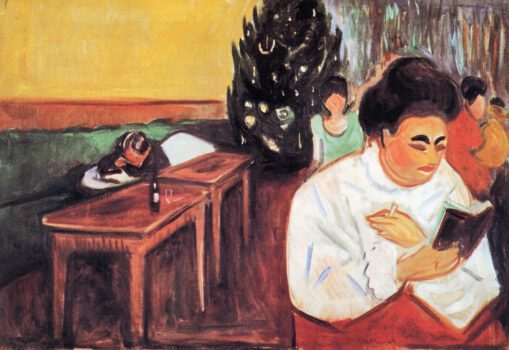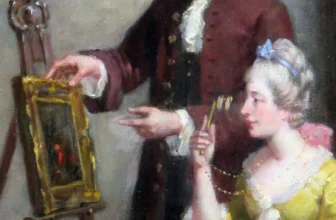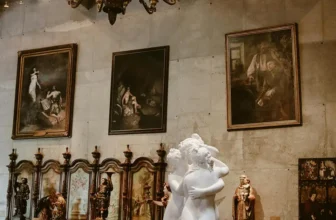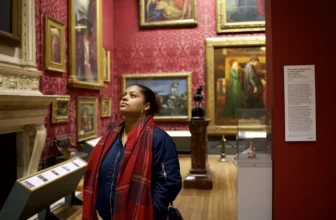Meaning of Christmas in the Brothel Painting by Edvard Munch
In the winter of modern art’s turbulent birth, few painters dared to challenge the conventions of morality, psychology, and social norms with the same brutal honesty and raw emotion as Edvard Munch. A Norwegian Symbolist and Expressionist whose work foreshadowed much of the existential and emotional unraveling of the 20th century, Munch was no stranger to darkness. His paintings were not created to please the eye but to penetrate the soul, and none exemplifies this mission more disturbingly and provocatively than Christmas in the Brothel (1895).
This lesser-known yet powerful painting pulls viewers into a dim, uneasy world where the sacred and the profane meet. Set not in a chapel or a family hearth but in a brothel, Christmas in the Brothel defies tradition and sentimentality. It invites us not to celebrate but to confront, the hypocrisy, alienation, and spiritual void beneath surface rituals. In this story-like analysis, we’ll delve deep into the artistic style, meaning, context, and current status of this haunting work.
The Birth of a Scandal
In 1895, Edvard Munch was deeply immersed in his emotional and psychological explorations of the human condition. That year, he was moving back and forth between Berlin and Paris, both epicenters of radical artistic change. The seeds of Modernism were being sown, and Munch was at the forefront, painting not what he saw but what he felt.
Christmas in the Brothel was born in this fertile, if tumultuous, period. At the time, Munch was working on his celebrated Frieze of Life series, an exploration of love, anxiety, jealousy, pleasure, and death. While Christmas in the Brothel was not part of this formal series, it shares its thematic DNA. In fact, it may be seen as an unflinching offshoot, a peripheral nightmare echoing the same emotional and existential concerns.
The painting was executed using oil on canvas, a medium Munch often manipulated to convey his emotional intensity. His brushwork in this piece is loose and raw, verging on grotesque in places, giving the entire composition a feverish, dreamlike quality. The figures appear simultaneously grounded in the physical world and untethered from it, as though caught in a spiritual purgatory.
What Is Happening in the Painting? A Visual Breakdown
At first glance, Christmas in the Brothel is jarring. It depicts a scene within a brothel, where a group of women, presumably working girls of pleasure, linger together in a shared space. One of them stands out: she is dressed in bright red, possibly suggesting she is the Madame or simply a symbolic focal point. The room is claustrophobic. There is no Christmas tree, no lights, no visible joy. The title alone is ironic, clashing violently with the visual.
There is an unsettling stillness in the painting. The women are not engaging with each other or with the viewer. Instead, they appear weary, resigned, perhaps even indifferent. Their expressions range from blank to melancholic. Some sit slumped in chairs, others lean against walls. Despite their physical proximity, there is emotional isolation. This is not a gathering of celebration, it is one of containment, of emotional exile.
Munch includes male figures as well, but they are less defined, spectral even. They blend into the background like shadows or memories, perhaps meant to represent clients or the looming presence of male desire that governs the space.
The color palette, sickly yellows, bruised purples, and splashes of aggressive red, evokes a mood of decay and discomfort. Shadows fall heavily across the room, especially around the eyes of the figures, accentuating their inner emptiness. If there is a Christmas spirit here, it is one distorted beyond recognition.
The Meaning: Christmas Reimagined
So, what does this painting mean? What is Munch trying to tell us by setting a “Christmas” scene in a brothel?
At its core, Christmas in the Brothel is a work of confrontation. It challenges the viewer to reevaluate the cultural and religious significance of Christmas, traditionally a time of love, family, and spiritual reflection, by placing it in a location associated with transactional pleasure, marginalization, and moral judgment.
Munch is not merely being provocative for shock’s sake. Rather, he is pointing out a profound societal hypocrisy: the separation between public virtue and private vice. By painting the interior of a brothel and titling it after Christianity’s most sacred holiday, he collapses the dichotomy between sacred and profane. The painting becomes an indictment of social and religious pretense.
It may also reflect Munch’s own conflicted views on pleasure, women, and religion. A deeply troubled man with a history of psychological trauma, Munch’s personal relationships with women were often turbulent. He viewed women pleasure as both irresistible and destructive. In this light, the brothel becomes a metaphor not just for society’s failings, but for Munch’s own inner torment.
The Christmas setting, then, is bitterly ironic. There is no divine birth here, only spiritual death.
Symbolism: Layers Beneath the Flesh
The painting is rife with symbolic elements that deepen its psychological impact:
1. The Red Dress
One woman’s bright red dress stands in stark contrast to the drabness of the rest of the scene. Red, traditionally associated with passion, vitality, and sin, may symbolize both erotic power and the “scarlet letter” of societal judgment. She becomes a Christ-like figure in reverse, not sacrificed for humanity, but commodified by it.
2. Emotional Distance
The disconnectedness between figures symbolizes the alienation not only of pleasure workers from society, but of individuals from each other. In a space meant for intimacy, no one truly connects. Munch uses physical closeness to emphasize emotional distance, a paradox he often employed in his other works.
3. Light and Shadow
The murky lighting and deep shadows suggest a kind of moral fog. There is no divine illumination here, no guiding star, only the flickering instability of human desire and regret.
4. The Room Itself
The brothel is rendered as a kind of modern-day purgatory, a place where souls linger, unredeemed. Its spatial constriction mirrors the inner confinement of its occupants.
Expressionism and Symbolism
Christmas in the Brothel is a prime example of early Expressionism with Symbolist undertones. It is not concerned with accurate representation but emotional truth. The distorted figures, moody colors, and dreamlike composition all reflect Munch’s preoccupation with inner psychological states.
Expressionism
As one of the pioneers of Expressionism, Munch painted not the world as it is, but as it feels. His brushwork is volatile, his use of color deliberately unsettling. The emotions of the figures are not expressed through detailed facial features but through posture, atmosphere, and symbolic placement.
Symbolism
There is a deep undercurrent of Symbolist ideology in this work, the idea that art should represent absolute truths through metaphor. The brothel becomes a stand-in for moral decay, the red dress for sin and sacrifice, the entire painting a dark mirror to Christian iconography.
In many ways, this piece is the inverse of a Nativity scene. Instead of Mary, Joseph, and the Christ child bathed in holy light, we see women in various states of despair, cast in shadows. Instead of hope, we have resignation. Instead of salvation, commodification.
Where Is the Painting Now?
Today, Christmas in the Brothel resides at the Munch Museum (Munchmuseet) in Oslo, Norway. The museum is home to the largest collection of Edvard Munch’s work in the world, including over 1,000 paintings, 4,500 drawings, and 18,000 prints.
The Munch Museum continues to exhibit Christmas in the Brothel on rotation with his other emotionally charged masterpieces such as The Scream, Madonna, and The Dance of Life. It is an essential part of understanding Munch’s broader oeuvre and is often included in thematic exhibitions that explore love, death, and psychological complexity.
Interpretation
While Christmas in the Brothel has not achieved the iconic status of The Scream, it remains a deeply significant painting in Munch’s body of work. It exemplifies his fearless willingness to grapple with taboo subjects and strip away illusions.
Critics and scholars continue to debate its implications. Some see it as a feminist indictment of a society that exploits and discards women, especially pleasure workers. Others interpret it as a deeply personal exorcism of Munch’s own guilt and religious conflict.
What remains certain is its power. Few paintings deliver such an unsettling mixture of beauty, revulsion, and sorrow. It is, in every sense, a confrontation, between viewer and subject, tradition and transgression, holiday and hollowness.
A Christmas Carol in Minor Key
Christmas in the Brothel is not a painting that comforts. It is one that demands we look beyond decoration and tradition, deep into the shadows of human experience. In Munch’s hands, Christmas becomes not a celebration, but a moment of existential reckoning.
This is not a season of hope, but a time when the veil between appearances and reality is at its thinnest. The brothel is not just a physical place but a metaphor for a society that has lost its soul, its empathy, its connection, its truth. In the quiet sadness of the women’s faces, we are reminded of all those left out of the season’s joy.
In this way, Munch’s painting is perhaps the most honest Christmas image ever made, not because it celebrates, but because it mourns. And in that mourning, it forces us to reconsider what we value, what we ignore, and what we choose to sanctify.
It is a ghost story for Christmas, painted not in snow and sleigh bells, but in shadow and silence.




